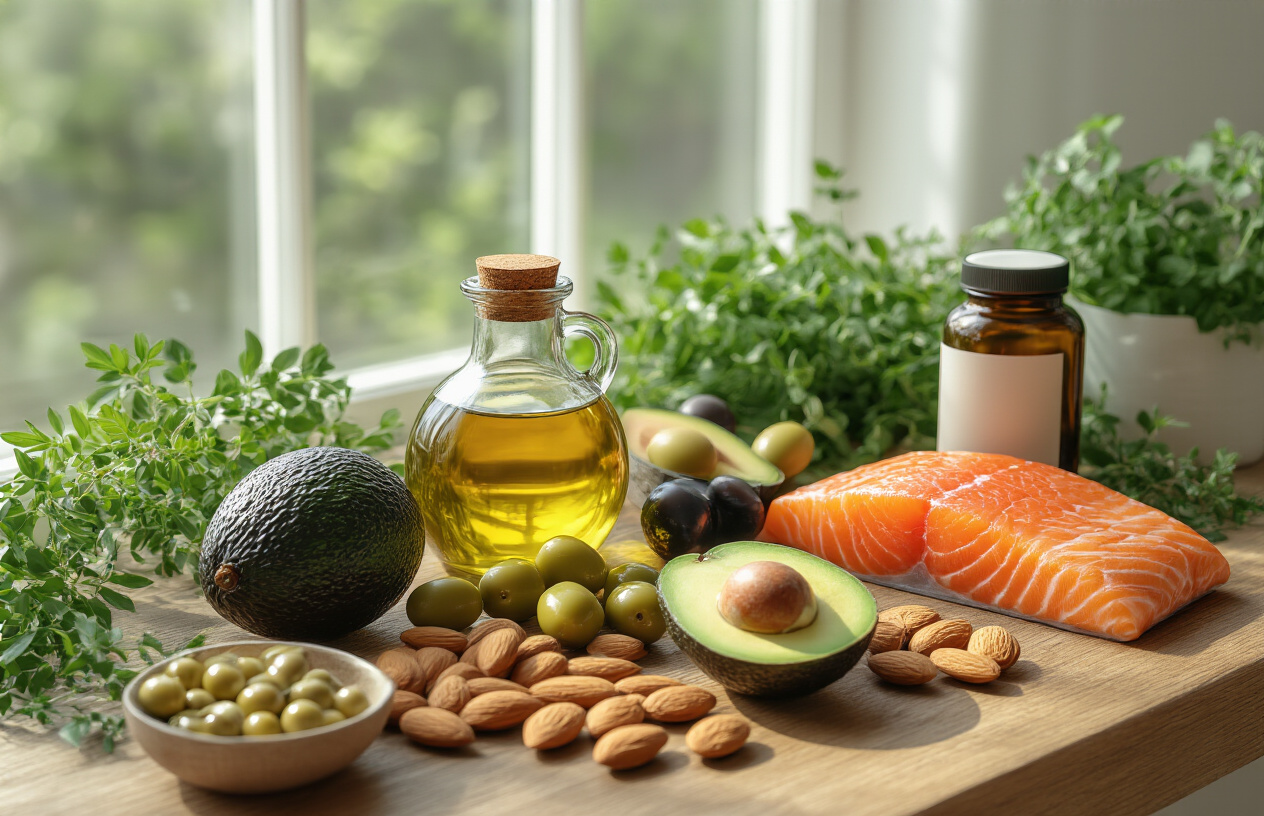W9-Fatty Acid: The Underrated Fat Your Body Needs
W9-fatty acid doesn’t get as much attention as its omega-3 and omega-6 cousins, but this essential nutrient plays a crucial role in your health. This guide is perfect for health-conscious individuals, nutrition enthusiasts, and anyone curious about optimizing their fat intake through diet or supplements.
We’ll break down what makes W9-fatty acids special and why your body depends on them for optimal function. You’ll discover the best food sources to include in your daily meals and learn realistic daily intake recommendations that fit your lifestyle. We’ll also explore high-quality supplement options and cover important safety considerations to help you make informed choices about adding W9-fatty acid to your wellness routine.
Understanding W9-Fatty Acids and Their Unique Properties

Chemical structure and molecular composition of W9-fatty acids
W9-fatty acids, also known as omega-9 fatty acids, feature a distinctive molecular structure with the first double bond located at the ninth carbon atom from the methyl end of the fatty acid chain. The most abundant and well-studied W9-fatty acid is oleic acid (C18:1n-9), which contains 18 carbon atoms with a single double bond in the cis configuration at position 9.
The molecular formula for oleic acid is C₁₈H₃₄O₂, and its systematic name is (Z)-octadec-9-enoic acid. This monounsaturated structure gives W9-fatty acids their unique properties, including fluidity at room temperature and resistance to oxidation compared to polyunsaturated fats. Other notable W9-fatty acids include erucic acid (C22:1n-9) and nervonic acid (C24:1n-9), which have longer carbon chains but maintain the same omega-9 positioning.
Key differences between W9 and other omega fatty acids
W9-fatty acids stand apart from their omega-3 and omega-6 counterparts in several critical ways. The most significant difference lies in their essential fatty acid status – while omega-3 and omega-6 fatty acids are considered essential because the human body cannot synthesize them, W9-fatty acids are non-essential since our bodies can produce them through the enzyme stearoyl-CoA desaturase.
| Fatty Acid Type | Double Bond Position | Essential Status | Primary Function |
|---|---|---|---|
| Omega-3 (W3) | 3rd carbon | Essential | Anti-inflammatory, brain health |
| Omega-6 (W6) | 6th carbon | Essential | Cell membrane structure, inflammation |
| Omega-9 (W9) | 9th carbon | Non-essential | Energy, heart health, inflammation balance |
W9-fatty acids also demonstrate superior oxidative stability compared to omega-3 and omega-6 fatty acids, making them excellent for cooking at higher temperatures without forming harmful compounds.
Natural sources where W9-fatty acids are found
Olive oil reigns as the richest dietary source of W9-fatty acids, containing approximately 55-83% oleic acid depending on the variety and processing method. Extra virgin olive oil provides the highest concentration along with beneficial antioxidants that work synergistically with the omega-9 content.
Other excellent sources include:
- Nuts and seeds: Macadamia nuts (58-62% oleic acid), almonds, hazelnuts, and sunflower seeds
- Avocados: Fresh avocados contain about 70% oleic acid in their oil content
- Animal fats: Lard, tallow, and poultry fat naturally contain significant omega-9 levels
- Other oils: Canola oil, high-oleic sunflower oil, and safflower oil varieties
- Olives: Both green and black olives provide concentrated W9-fatty acids
The concentration of W9-fatty acids in these sources can vary based on growing conditions, processing methods, and storage practices.
How your body processes and utilizes W9-fatty acids
When you consume W9-fatty acids, your digestive system breaks them down through pancreatic lipase enzymes, allowing absorption in the small intestine. Once absorbed, these fatty acids travel through the lymphatic system before entering the bloodstream as part of chylomicrons.
Your body incorporates W9-fatty acids into cell membranes, where they help maintain optimal membrane fluidity and function. The liver plays a central role in W9 metabolism, using these fatty acids for energy production through beta-oxidation or storing them as triglycerides. Your body can also synthesize oleic acid from saturated fats when dietary intake is insufficient.
W9-fatty acids influence gene expression related to lipid metabolism and inflammation. They activate peroxisome proliferator-activated receptors (PPARs), which regulate genes involved in fatty acid oxidation and glucose metabolism. This mechanism explains why W9-fatty acids can help improve insulin sensitivity and support healthy cholesterol profiles when consumed as part of a balanced diet.
Essential Health Benefits of W9-Fatty Acids

Cardiovascular Health Improvements and Heart Protection
W9-fatty acids play a remarkable role in supporting heart health through multiple pathways. These beneficial fats help regulate cholesterol levels by increasing HDL (good cholesterol) while reducing LDL (bad cholesterol) oxidation. This dual action creates a protective environment for your arteries, reducing the risk of plaque buildup that can lead to heart disease.
The anti-thrombotic properties of W9-fatty acids help maintain healthy blood flow by preventing excessive blood clotting. This natural blood-thinning effect reduces the likelihood of dangerous clots forming in your coronary arteries. Research shows that people with higher W9-fatty acid intake have significantly lower rates of sudden cardiac death and overall cardiovascular mortality.
Blood pressure regulation is another key benefit. W9-fatty acids help relax blood vessel walls, improving elasticity and reducing the workload on your heart. This vascular flexibility translates to better circulation and lower blood pressure readings, particularly beneficial for those with hypertension.
Brain Function Enhancement and Cognitive Support
Your brain thrives on healthy fats, and W9-fatty acids are essential building blocks for optimal neurological function. These fats make up a significant portion of brain cell membranes, directly influencing how neurons communicate with each other. Better membrane fluidity means faster signal transmission and improved cognitive processing.
Memory formation and retention see notable improvements with adequate W9-fatty acid intake. These fats support the production of neurotransmitters like dopamine and serotonin, which regulate mood, focus, and learning capacity. Studies demonstrate that people with higher W9-fatty acid levels perform better on memory tests and show enhanced problem-solving abilities.
Neuroprotection is perhaps the most exciting benefit for long-term brain health. W9-fatty acids help shield brain cells from oxidative damage and reduce the risk of neurodegenerative diseases. They support the formation of new neural pathways, a process called neuroplasticity, which keeps your brain adaptable and resilient as you age.
Anti-Inflammatory Properties for Joint and Tissue Health
Chronic inflammation underlies many health conditions, and W9-fatty acids serve as powerful natural anti-inflammatory agents. They work by modulating the production of inflammatory compounds called prostaglandins and leukotrienes, shifting your body’s response away from excessive inflammation toward healing and repair.
Joint health benefits are particularly pronounced for people with arthritis or exercise-related joint stress. W9-fatty acids help reduce morning stiffness, joint swelling, and pain intensity. They support cartilage health by maintaining the synovial fluid that lubricates joints, allowing for smoother movement and reduced wear and tear.
Tissue recovery and wound healing accelerate when your body has sufficient W9-fatty acids. These fats help regulate the inflammatory phase of healing, preventing it from becoming chronic while promoting the resolution phase where tissues actually repair themselves. Athletes often notice faster recovery times and reduced muscle soreness when maintaining optimal W9-fatty acid levels.
The systemic anti-inflammatory effects extend beyond joints to benefit skin health, digestive function, and immune system regulation. This whole-body approach to inflammation management helps create an internal environment where healing and optimal function can flourish.
Optimal Dietary Sources and Daily Requirements

Top food sources rich in W9-fatty acids
Olive oil stands out as the most concentrated dietary source of oleic acid, the primary W9-fatty acid. Extra virgin olive oil contains approximately 70-80% oleic acid by weight, making it an exceptional choice for daily consumption. Avocados follow closely, providing about 10-15 grams of oleic acid per fruit along with additional nutrients that support absorption.
Nuts deliver impressive amounts of W9-fatty acids, with almonds, hazelnuts, and macadamia nuts leading the pack. A single ounce of almonds provides roughly 9 grams of oleic acid, while hazelnuts offer about 8 grams per ounce. Seeds like sunflower and sesame seeds also contribute meaningful amounts to your daily intake.
Animal sources include fatty fish such as salmon and sardines, which provide W9-fatty acids alongside omega-3s. Grass-fed beef and free-range poultry contain moderate levels, though the concentration varies based on the animals’ diet and living conditions.
Cooking oils derived from high-oleic varieties of safflower, sunflower, and canola offer concentrated sources for meal preparation. These specially cultivated varieties contain 70-80% oleic acid content, rivaling olive oil’s concentration.
Recommended daily intake levels for different age groups
Current research suggests adults should aim for 15-20% of their total daily calories from monounsaturated fats, primarily W9-fatty acids. For a typical 2,000-calorie diet, this translates to approximately 33-44 grams daily.
Age-specific recommendations:
| Age Group | Daily Intake (grams) | Percentage of Calories |
|---|---|---|
| Children 2-8 years | 15-20g | 15-18% |
| Adolescents 9-18 years | 20-30g | 16-19% |
| Adults 19-50 years | 30-40g | 17-20% |
| Adults 51+ years | 25-35g | 15-18% |
| Pregnant women | 35-45g | 18-21% |
| Breastfeeding women | 40-50g | 19-22% |
Athletes and individuals with higher caloric needs may require proportionally more W9-fatty acids to support energy demands and recovery processes. Those following ketogenic or low-carb diets often consume higher percentages safely.
Absorption factors that maximize nutritional benefits
W9-fatty acid absorption depends heavily on consuming them alongside fat-soluble vitamins A, D, E, and K. Pairing oleic acid-rich foods with vegetables containing these vitamins creates synergistic effects that boost overall nutrient uptake.
Temperature affects absorption rates significantly. Room temperature or slightly warmed fats absorb more efficiently than cold ones. This explains why Mediterranean cultures traditionally consume olive oil at room temperature or gently warmed in cooking.
Meal timing plays a crucial role in maximizing benefits. Consuming W9-fatty acids earlier in the day allows for better utilization throughout daily activities. Your digestive system processes fats more effectively when not competing with large amounts of simple carbohydrates.
The presence of digestive enzymes, particularly lipase, directly impacts how well your body breaks down and absorbs these fatty acids. Eating slowly and chewing thoroughly stimulates natural enzyme production. Some people benefit from digestive enzyme supplements, especially those with compromised digestive function.
Fiber intake affects absorption patterns. Moderate amounts of soluble fiber can slow absorption in a beneficial way, preventing rapid spikes in blood fat levels. However, excessive fiber may interfere with optimal uptake.
Plant-based versus animal-based W9 sources comparison
Plant sources typically provide more concentrated W9-fatty acid content with fewer saturated fats. Olive oil, avocados, and nuts deliver oleic acid without the cholesterol found in animal products. Plant sources also include beneficial compounds like polyphenols and vitamin E that protect against oxidation.
Animal sources offer W9-fatty acids packaged with complete proteins and B vitamins not found in plant foods. Fish provides additional omega-3 fatty acids that work synergistically with W9s. However, animal sources often contain higher levels of saturated fats and cholesterol.
Comparative analysis:
| Source Type | W9 Content | Additional Benefits | Considerations |
|---|---|---|---|
| Plant oils | 70-80% | Antioxidants, vitamin E | Calorie-dense |
| Nuts/seeds | 40-60% | Protein, fiber, minerals | Portion control needed |
| Avocados | 60-70% | Fiber, potassium, folate | Seasonal availability |
| Fish | 20-30% | Omega-3s, protein | Mercury concerns |
| Poultry | 30-40% | Complete protein | Saturated fat content |
Plant sources generally cost less per gram of W9-fatty acids and have longer shelf lives when stored properly. They also align with environmental sustainability goals and various dietary restrictions.
Processing methods significantly impact both plant and animal sources. Cold-pressed plant oils retain more nutrients than heat-processed versions. Wild-caught fish typically contains higher W9 levels than farm-raised alternatives.
Supplement Options and Quality Considerations

Types of W9-fatty acid supplements available
The supplement market offers several forms of W9-fatty acid supplementation, each with distinct advantages for different users. Softgel capsules represent the most popular option, providing pre-measured doses in an easy-to-swallow format that protects the oils from oxidation. These typically contain concentrated W9 fatty acids derived from high-oleic sunflower oil or specially processed olive oil extracts.
Liquid supplements offer faster absorption rates and allow for flexible dosing adjustments. Many users prefer adding these to smoothies or taking them directly, though they require refrigeration and have shorter shelf lives than capsules.
Powder formulations work well for people who struggle with pills or prefer mixing supplements into foods. These often combine W9 fatty acids with other nutrients but may have lower bioavailability compared to oil-based formats.
Combination supplements blend W9 fatty acids with omega-3s, omega-6s, or fat-soluble vitamins. While convenient, these products may not provide optimal ratios for individual needs.
| Supplement Type | Absorption Rate | Shelf Life | Dosing Flexibility |
|---|---|---|---|
| Softgel Capsules | Moderate | Long | Limited |
| Liquid | High | Short | High |
| Powder | Lower | Moderate | Moderate |
| Combination | Variable | Long | Limited |
Purity standards and third-party testing importance
Quality varies dramatically across W9-fatty acid supplements, making third-party testing essential for safety and effectiveness. Look for products certified by independent laboratories like NSF International, USP, or ConsumerLab. These organizations verify that supplements contain the stated amounts of active ingredients without harmful contaminants.
Heavy metal contamination poses a significant concern, especially in fish-derived or poorly processed plant oils. Mercury, lead, cadmium, and arsenic can accumulate in fatty acid supplements, potentially causing health problems with long-term use. Reputable manufacturers test every batch and publish certificates of analysis.
Oxidation levels directly impact supplement effectiveness. Rancid oils not only taste terrible but may actually promote inflammation rather than reducing it. Quality supplements measure peroxide values and anisidine values to ensure freshness. Products should list harvest dates, processing methods, and storage recommendations.
Solvent residues from extraction processes can leave chemical traces in finished products. Cold-pressed or CO2-extracted supplements typically contain fewer residues than those using hexane or other industrial solvents.
Always choose brands that voluntarily submit to regular third-party audits and make testing results publicly available. Avoid products with proprietary blends that hide individual ingredient amounts.
Proper dosage guidelines for supplementation
W9-fatty acid dosing depends on individual health goals, existing dietary intake, and overall nutritional status. General maintenance doses typically range from 500-1000mg daily for healthy adults, while therapeutic applications may require 1500-3000mg under professional guidance.
Timing matters significantly for optimal absorption. Taking W9-fatty acid supplements with meals containing other fats enhances bioavailability by stimulating bile production. Avoid taking them with high-fiber foods that might interfere with fat absorption.
Start low and increase gradually to assess individual tolerance. Some people experience mild digestive upset initially, which usually resolves within a few days. Beginning with 250-500mg daily allows your system to adjust before reaching therapeutic doses.
Monitor your response through both subjective feelings and objective markers when possible. Keep a simple log noting energy levels, inflammation symptoms, or other targeted health concerns. Blood tests measuring inflammatory markers can provide objective feedback for higher therapeutic doses.
Special populations require modified dosing approaches:
- Pregnant women: Consult healthcare providers before supplementing
- Children: Use pediatric formulations with age-appropriate dosing
- Elderly adults: May need higher doses due to reduced absorption efficiency
- Athletes: Often benefit from higher doses during intense training periods
Cycle supplementation occasionally to prevent potential imbalances with other fatty acids in your system.
Potential Side Effects and Safety Precautions

Common adverse reactions and risk factors
Most people tolerate omega-9 fatty acids well, but some individuals may experience digestive issues like nausea, stomach upset, or diarrhea, especially when starting supplementation or taking high doses. These symptoms typically occur when taking more than 3-4 grams daily and often subside as your body adjusts.
Weight gain represents another concern, particularly for those consuming large amounts of omega-9 rich oils. Since these are calorie-dense nutrients (9 calories per gram), excessive intake can contribute to unwanted pounds. People with existing gallbladder problems should exercise caution, as high-fat intake may trigger gallbladder attacks.
Individuals with bleeding disorders or those scheduled for surgery should be particularly careful. While omega-9s are generally safer than omega-3s regarding bleeding risk, high doses might still affect blood clotting. Stop supplementation at least two weeks before planned surgery.
Drug interactions and contraindications
Omega-9 fatty acids can interact with several medications, requiring careful monitoring and potential dose adjustments. Blood-thinning medications like warfarin, aspirin, and clopidogrel may have enhanced effects when combined with high-dose omega-9 supplements, increasing bleeding risk.
Diabetes medications require attention since omega-9s can influence blood sugar levels. Regular monitoring becomes essential for people taking insulin or oral hypoglycemic drugs. Blood pressure medications may also interact, as omega-9s can have mild blood pressure-lowering effects.
| Medication Type | Interaction Level | Monitoring Required |
|---|---|---|
| Anticoagulants | High | Weekly INR checks |
| Diabetes medications | Moderate | Daily blood glucose |
| Blood pressure drugs | Low | Monthly BP readings |
| Cholesterol medications | Minimal | Quarterly lipid panels |
People taking immunosuppressive drugs should consult their healthcare provider before starting omega-9 supplements, as these fatty acids may influence immune function.
Special considerations for pregnant and nursing women
Pregnant women can generally consume omega-9 fatty acids through food sources without concern, as these nutrients support fetal brain development and maternal health. However, supplementation during pregnancy requires medical supervision to ensure appropriate dosing.
The recommended approach focuses on food-based sources like olive oil, avocados, and nuts rather than concentrated supplements. These whole food sources provide omega-9s alongside other beneficial nutrients without the risk of excessive intake.
Nursing mothers should maintain similar caution with supplements while freely enjoying omega-9 rich foods. The fatty acids do pass into breast milk, potentially benefiting infant development, but concentrated supplements might provide more than necessary.
Key considerations for expectant and nursing mothers:
- Prioritize whole food sources over supplements
- Limit olive oil intake to 2-3 tablespoons daily
- Avoid high-dose omega-9 supplements without medical approval
- Monitor weight gain carefully due to calorie density
- Discuss any supplementation plans with healthcare providers
Monitoring guidelines for long-term supplementation
Long-term omega-9 supplementation requires periodic assessment to ensure safety and effectiveness. Begin with baseline measurements including lipid panels, liver function tests, and inflammatory markers before starting supplementation.
Schedule follow-up testing every 3-6 months during the first year, then annually if results remain stable. Key markers to monitor include:
Essential Tests:
- Complete lipid profile (total cholesterol, LDL, HDL, triglycerides)
- Liver enzymes (ALT, AST)
- Inflammatory markers (CRP)
- Body weight and BMI
Optional Tests:
- Omega fatty acid profile
- Coagulation studies (if bleeding risk factors present)
- HbA1c (for diabetics)
Watch for warning signs that suggest discontinuing supplementation: persistent digestive issues, unexplained weight gain exceeding 5 pounds, elevated liver enzymes, or unusual bleeding. Regular communication with your healthcare provider helps identify potential issues early and adjust dosing as needed.
Most people can safely take omega-9 supplements long-term when properly monitored, but individual responses vary significantly, making personalized assessment crucial for optimal outcomes.

W9-fatty acids offer remarkable health benefits that make them worth adding to your daily routine. From supporting heart health and reducing inflammation to boosting brain function, these unique fats play crucial roles in keeping your body running smoothly. The best part is that you can easily get them through everyday foods like olive oil, nuts, and avocados, making it simple to meet your daily needs without breaking the bank.
If you’re considering supplements, stick with reputable brands and always check with your doctor first, especially if you have existing health conditions. Start slowly with any new addition to your diet and pay attention to how your body responds. By making small, consistent changes to include more W9-fatty acids in your meals, you’re taking a smart step toward better long-term health that your future self will thank you for.














